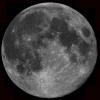3towers Observatory Moon web cam imaging

Mosaic of the Full Moon on December 23, 2007

The major features on the Moon are labeled
The 12-inch f/10 Meade LX 200 telescope at the
3towers Observatory was used for extensive Lunar
photography. The earliest images were taken at prime
focus with an f/6.3 focal reducer effectively operating at f/6.5 producing an 80-inch (2000 mm) focal
length. Later Lunar imaging used either the f/10 prime focus (focal
length 120-inches, 3000 mm) or a 2x Barlow system coupled
to the f/10 prime focus of the telescope. This later technique
gave a focal ratio of f/20 with a 240 inch (6000 mm) focal
length.
For Lunar and
planetary imaging, the telescope was equipped with a variety of
interchangeable web cameras. Initial imaging was performed
with a Philips ToUcam Pro PCVC740K web camera. Later
imaging used either a Lumenera SKYnxy 2-0 monochromatic
camera or a Lumenera SKYnyx 2-1 color camera.
Monochromatic or color images were obtained depending on the sky
conditions and the result desired result.
Since June 2014, a Celesteron 14-inch f/11 telescope situated in a second dome (Dome 2) has been used for lunar and planetary imaging, either at f/11 3910 mm (154 inches) focal length or at f/22 7820 mm (308 inches) focal length. This telescope is currently used with a ZWO ASI1034 web camera.
General Formula:
D = (W x 3438) / (F)
Where D is field of
view in arcminutes, F is focal length, and W is the size of a chip dimension
length or width (pixel
size x # pixels). F and W have to be in the same units.
For the C-14 telescope:
f/11 = 3910 mm or 3,910,000 microns
f/22 = 2X Barlow = 7820 mm or 7,820,000 microns
I. Philips ToUcam
Pro PCVC740K web camera contains a CCD chip with 640 x 480 5.6 micron pixels.
f/11 = 3.15 x 2.4 arcminutes 0.30 arcseconds/pixel
f/22 = 1.6 x 1.2 arcminutes
0.15 arcseconds/pixel
II. Lumenera SKYnyx 2-0 contains a CCD chip with 640 x 480 7.4 micron
pixels:
f/11 = 4.16 x 3.12 arcminutes
0.39 arcseconds/pixel
f/22 = 2.08 x 1.6 arcminutes
0.18 arcseconds/pixel
III. Lumenera SKYnyx 2-1 contains a CCD chip with 1392 x 1040 4.65
micron pixels.
f/11 = 5.69 x 4.27 arcminutes
0.25 arcseconds/pixel
f/22 = 2.85 x 2.14 arcminutes
0.13 arcseconds/pixel
IV. ZWO ASI1034 contains a CCD chip with 728 x 512 5.6 micron pixels
f/11 = 3.58 x 2.69 arcminutes 0.30 arcseconds/pixel
f22 = 1.80 x 1.35 arcminutes 0.15 arcseconds/pixel |
